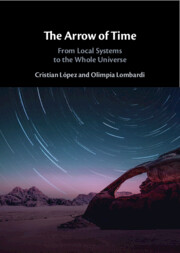Book contents
- The Arrow of Time
- The Arrow of Time
- Copyright page
- Contents
- Contributors
- Preface
- Acknowledgments
- Part I Local Systems
- Part II The Arrow of Time and Philosophical Issues
- 4 Explaining the Psychological Arrow of Time in Time-Symmetric Physics
- 5 The Consequence Argument Meets the Mentaculus
- 6 “Freedom from the Inside Out”: Revisited
- 7 The Arrow of Time Is Alive and Well but Forbidden under the Received View in Physics
- Part III The Arrow of Time and Time-Reversal Invariance
- Part IV The Whole Universe
- Index
- References
7 - The Arrow of Time Is Alive and Well but Forbidden under the Received View in Physics
from Part II - The Arrow of Time and Philosophical Issues
Published online by Cambridge University Press: 28 October 2025
- The Arrow of Time
- The Arrow of Time
- Copyright page
- Contents
- Contributors
- Preface
- Acknowledgments
- Part I Local Systems
- Part II The Arrow of Time and Philosophical Issues
- 4 Explaining the Psychological Arrow of Time in Time-Symmetric Physics
- 5 The Consequence Argument Meets the Mentaculus
- 6 “Freedom from the Inside Out”: Revisited
- 7 The Arrow of Time Is Alive and Well but Forbidden under the Received View in Physics
- Part III The Arrow of Time and Time-Reversal Invariance
- Part IV The Whole Universe
- Index
- References
Summary
This chapter offers a meta-level analysis in the sociology and history of physics in the context of the “Arrow of Time” or the so-called Two Times problem. In effect, it argues that the two topics are intertwined, and it is only by coming to grips with the sociological aspects, involving adherence to certain metaphysical, epistemological, and methodological assumptions. Our argument is that the so-called Arrow of Time Problem or Two Times Problem (TTP) is essentially a myth. It is an article of faith that is contradicted by actual theoretical practice, in which the applicable physical theory does possess an Arrow of Time and must do so in order to account for the propagation of real energy and other conserved currents. Belief in the TTP is upheld only through entrenched adherence to a set of primarily metaphysical beliefs of a predominant Received View of physics that themselves are contradicted by the empirical facts, by current theory, and by inconsistencies among the beliefs themselves.
Information
- Type
- Chapter
- Information
- The Arrow of TimeFrom Local Systems to the Whole Universe, pp. 140 - 158Publisher: Cambridge University PressPrint publication year: 2025
References
Accessibility standard: WCAG 2.1 AA
Why this information is here
This section outlines the accessibility features of this content - including support for screen readers, full keyboard navigation and high-contrast display options. This may not be relevant for you.Accessibility Information
Content Navigation
Allows you to navigate directly to chapters, sections, or non‐text items through a linked table of contents, reducing the need for extensive scrolling.
Provides an interactive index, letting you go straight to where a term or subject appears in the text without manual searching.
Reading Order & Textual Equivalents
You will encounter all content (including footnotes, captions, etc.) in a clear, sequential flow, making it easier to follow with assistive tools like screen readers.
You get concise descriptions (for images, charts, or media clips), ensuring you do not miss crucial information when visual or audio elements are not accessible.
Visual Accessibility
You will still understand key ideas or prompts without relying solely on colour, which is especially helpful if you have colour vision deficiencies.
Structural and Technical Features
You gain clarity from ARIA (Accessible Rich Internet Applications) roles and attributes, as they help assistive technologies interpret how each part of the content functions.
